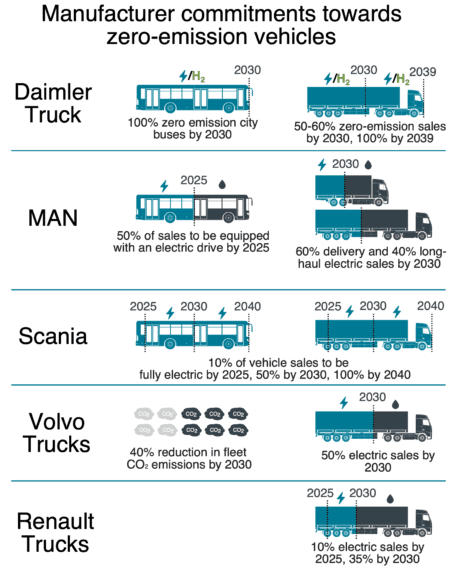Blog
A story of transition: How Europe’s faring in its move to zero-emission trucks and buses
Few dispute that Europe’s trucks and buses need to decarbonize, and even fewer dispute the scale of the challenge that lies ahead. These behemoths of the road are responsible for 25% of Europe’s road transport emissions, despite only accounting for 2.5% of vehicles. Last year, we published a deep-dive analysis into the current state of the heavy-duty market, and how manufacturers are poised for the inevitable zero-emission transition. Here we revisit the story and provide an update into how the market has continued to fare.
There are many sides to every story, so let’s take a look at the two biggest chapters here: demand and supply.
Demand: Low but growing fast
Supply: A growing numbers of models, but not all the right types
Even if there’s a growing appetite for zero-emission heavy-duty vehicles, if what you want isn’t on the menu, then you won’t be ordering.
Today, there’s about 55 variations of zero-emission buses available for sale, and 74 models of trucks, some of which are only in small scale production (we’ve documented each of them in this excel file). The trouble is, not a lot of great options are available for the highest emitters. Tractor trailers make up about 60% of the emissions from trucks, but only 35% of zero-emission models. And most have a maximum range below 400 km, which would only cover about 40% of the daily mileage traveled by a tractor-trailer today. And while there are a lot of zero-emission buses, very few coaches are available—just four by our count. Attempts to fully decarbonize the heavy-duty sector will hit a roadblock in the absence of diversity.
Model availability may not be the only supply-side problem. It’s also vital that manufacturers invest early in adapting their business model to ensure that when orders are placed for zero-emission vehicles, their production capacity can meet consumers’ growing demand.
The technology shift is opening the heavy-duty market to some new players. The truck and bus markets have been historically homogenous; the top seven truck manufacturers are responsible for about 97% of the sales today. However, we found the same big seven to be responsible for just one third of the zero-emission models on the market, with smaller manufacturers starting to gain an early foothold in the zero-emission market.
The chart below summarizes the models we found available for sale. Hover over each point to see some additional info on things like the model’s name, manufacturer, and battery capacity. Circles describe battery electric vehicles, and plus signs represent fuel cell electric vehicles.

Sources:
Trucks: Daimler Truck (2030), Daimler Truck (2039), MAN, Scania (2025/2030), Scania (2040), Volvo Trucks, Renault Trucks (2025), Renault Trucks (2030)
Buses: Daimler Truck, MAN, Scania (2025/2030), Scania (2040), Volvo Trucks
Regulation: The long and binding road
So, demand is low but growing, and supply is gearing up to meet the transition that’s yet to come. But there’s a third side to this story we haven’t talked much about, and that’s regulation.
CO2 standards are in place for most trucks for 2025 and 2030. Manufacturers have already committed to go far beyond what these standards require. The European Commission intends to revise these standards at the end of the year (although it looks like this might be postponed to early 2023 already), and this would be a prime opportunity to revise these targets in line with what manufacturers have already pledged—including a phase out of the internal combustion engine by 2040. The standards should also be extended to buses and medium trucks. Our previous analysis showed that doing so would get us remarkably close to meeting our climate targets.
There are of course countless other chapters to this story that have yet to be written, such as the provision of charging infrastructure to meet this demand, how to decarbonize the hard-to-electrify vehicle segments, and dealing with rising costs of rare earth metals. But setting the right regulation would make for a great start. And any great story needs a very good start.
